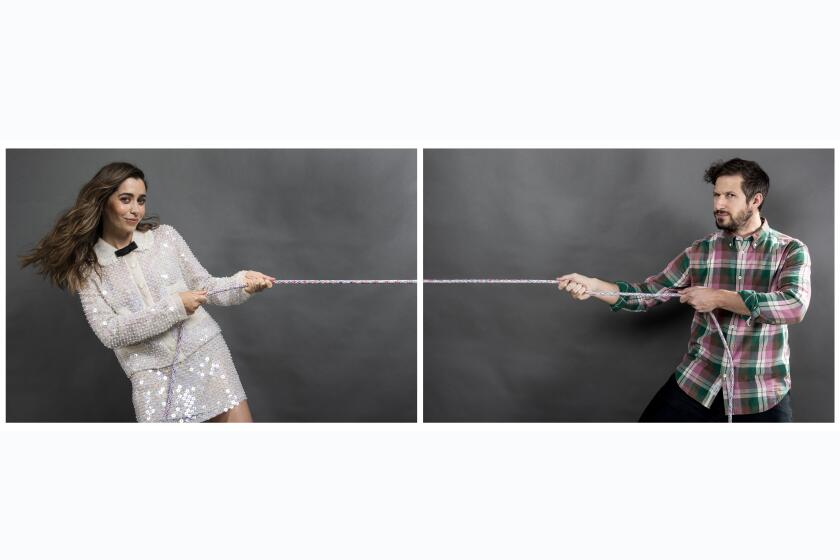How an editor helped make the soul-crushing repetition of a time loop entertaining
- Share via
In “Palm Springs,” Nyles (Andy Samberg) is a charismatic guy who just happens to be stuck in a time loop
where he repeats the same day over and over and over again.
The backdrop is a wedding, but living through the same joyous occasion nonstop has turned him apathetic — at least until he sets eyes on the maid of honor, Sarah (Cristin Milioti), who gets caught in the same dire circumstances with him. After the honeymoon of never needing to worry about real life again fades, the tables start to turn when she wants to find a way out, whereas he prefers to stay trapped in the same day together.
What are most rom-coms missing? Existential dread. Andy Samberg and Cristin Milioti deliver that with the laughs in ‘Palm Springs.’
For editor Matt Friedman (“The Farewell”), the challenge was structuring a story that features soul-crushing repetition without inflicting soul-crushing repetition on the audience. His tack was to flesh out the details beyond the screenplay.
“My style as an editor is to talk about the mechanics and the minutiae of everything,” Friedman says. “I don’t understand how I can tell a story if I don’t understand it explicitly, even if it’s something that isn’t necessarily going to be told to the audience.”
The visual journey was a detail-orientated process where “every frame mattered.” “I was careful to include exactly what was needed to tell the story,” he says. “Audiences are smart and will fill in the gaps. Allowing them to fill in those gaps is a way to make the movie more fulfilling and interactive. They get to be storytellers as well.”
Though Nyles and Sarah are living the same day, their arcs can progress contrarily. It was up to Friedman
to figure out how (and when) to shave unnecessary frames. In one instance, Sarah confronts Nyles at the swimming pool, demanding to know what he’s done to her. The audience gets to see it once from Nyles’ perspective and a second time through Sarah’s eyes.
“When we see her come out of the house for the first time and start to yell at Nyles, she grabs a beer can and starts to throw it at him. The second time she comes out, she never grabs the beer before she throws it — it magically appears in her hand. I did that intentionally,” Friedman says. “The audience has already seen what happened and knows where she gets the beer. Our brain is going to fill that information in the second time, and instead of it feeling like a jump cut, it’s going to feel continuous.”
In order to present the right information to the audience, Friedman wanted to know the subtext to make his decisions. Such an instance is in the case of knowing how long Nyles has been trapped inside the time loop — a plot point that’s never rightly answered.
“There’s a scene by the campfire where Sarah turns to him and asks what he did before he got sucked in. He takes a pause and goes, ‘I honestly don’t remember. It’s been so long.’ When we got to that point, I turned to director Max Barbakow and Andy [Samberg also served as producer] to ask if he’s lying or not,” Friedman recalls. “We had a whole detailed discussion about how long Nyles had been in there, whether or not he had been lying and why he’s answering the way he answers.”
Having an exhaustive understanding of the characters allowed Friedman to cut scenes more allegorical. “Even if we want the story point to be vague to the audience, for me, I can edit scenes so that performance is true and honest. If I’m cutting it one way, and Max has directed the actors another way, it’s going to feel disingenuous.”
Visual callbacks and subtitles were another area Friedman wanted to safeguard. A favorite of the editor’s is when Roy (J.K. Simmons), whom Nyles inadvertently pulls into the time loop, first walks into the wedding and takes a bite of a tuna appetizer and says “meh.” When Nyles shows up to his house later in the film, Roy happens to be cooking tuna.
“It’s why he’s so critical of the tuna at the wedding. He’s a tuna aficionado,” says Friedman. “Sometimes backstory can be unimportant to the mechanics of it all, but it makes the movie so rich.”
The most challenging sequence was cutting the life-in-the-time-loop montage where we see Nyles and Sarah do anything and everything they want. “It was a fine line to stride where we needed it to feel like a complete story from beginning to the end,” he says. “It had three parts: the first musical montage, a dance number inside the bar, and then a third montage. If it felt like three different things, it was going to feel redundant and worn out.”
To pull off the scene, musical transitions, along with the sound effects, were designed to make each moment feel like one continuous sequence.
“We were very aware that we wanted the montage to tell an arc. At the beginning, it’s one thing, and then by the end, they’ve essentially fallen in love with each other. And that’s what this story is really about. It’s about these two people who have given up in life and learn from each other not to give up. And, hopefully, they’re going to do it together.”
More to Read
From the Oscars to the Emmys.
Get the Envelope newsletter for exclusive awards season coverage, behind-the-scenes stories from the Envelope podcast and columnist Glenn Whipp’s must-read analysis.
You may occasionally receive promotional content from the Los Angeles Times.











